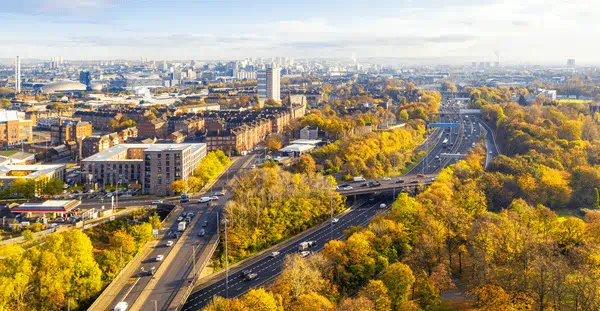The pace at which high speed broadband and mobile phone coverage are becoming our ‘new utilities’ is testimony to how essential both have become to modern life. We have seen commitments to a superfast fibre future from both main parties in this election, along with announcements about a £1 billion plan to extend mobile coverage to 95% of the UK landmass. The full fibre vison will cost an estimated £30 billion to deliver, and we are seeing a parallel 5G network push from mobile operators who need fibre to make the economics of their new networks sustainable. So how did we get here?
Fibre vs Copper connectivity
Politicians love to be able to point to the poor performance of the UK in the ‘full fibre’ league table, where we languish near the bottom - with Germany for company incidentally – with only 8% coverage. Rather than go ‘full fibre’, BT (and its German equivalent DT) had decided that sweating the old copper network was the best approach.
In its ‘Fibre to the Cabinet (FTTC)’ model, fibre goes from the BT exchange to a green street cabinet and then taps into the old copper network for that last few hundred meters to the home. Minimal disruption, low cost and decent performance in line with most people’s needs today.
But FTTC isn’t full fibre and new network operators like CityFibre, supported by mobile operators who need the capacity and economics of fibre, began to turn the tables with Gigabit-capable full fibre broadband. Eventually most of the major broadband providers recognised that if you can’t beat them, join them. Virgin kicked off Project Lightning and BT embarked on a £5 billion fibre build programme. The hope is that, whilst the equipment at the end may need to change, the fibre itself will offer limitless capability so is effectively ‘future proof’ and will be much cheaper to maintain than the venerable copper network it replaces.
Fibre for mobile operators
The full fibre vision has attracted huge private sector investment into fibre ‘altnets’. Mobile operators have been critical anchor tenants to underpin investor confidence and fibre was essential for mobile operator survival. And it really was survival, where the cost of ‘private circuit’ backhaul (the pipes that take traffic from the radio sites to the core) was growing in line with data traffic growth, but revenues were capped by ‘all you can eat’ tariffs. Fibre - with its potentially unlimited capacity – breaks that linkage once and for all. That’s why Vodafone partnered with CityFibre. That’s why altnets like SSE and Zayo are selling dark fibre to mobile operators.
Fibre to the premises (FTTP) is considered the best solution for broadband connectivity. It currently covers 4% of UK premises and is being rolled out to 3 million households a year. In contrast, while copper-based broadband meets current consumer needs, it is not scalable and has much higher operating costs.
The introduction of 5G technology could be a game-changer for rolling out full-fibre. In addition to enhanced mobile performance, 5G promises to support new business models based on the Internet of Things, such as connected and autonomous vehicles. However, 5G is dependent on availability of fast fibre connectivity, and the arrival of this latest mobile technology could not come at a better time to generate demand to underpin investment.
Fibre network roll-out
Unlike other large infrastructure undertakings such as Crossrail or Hinkley Point C, fibre roll-out can be done at a local scale. The physical work – duct laying, cable blowing and connections – is relatively straightforward, scalable and replicable. However, the size of the programme and the complexity of aspects like permitting, administration can create delivery risks. Across the 32 London boroughs, for example, there is little in the way of common permitting process, planning, road traffic management and highway authority activity, so there is huge scope for delays and waste.
Another big issue is obtaining wayleaves – essential legal access agreements that need to be in place before work on private property starts. Whereas regulated utilities such as gas and water have a statutory right of access that simplifies the process, fibre companies do not. Even running a cable across private land requires permissions, costing a minimum of around £2,000 for the simplest of agreements.
Installing fibre broadband can typically cost between £300 to £600 per premise, depending on the location (density will make urban locations cheaper to connect than deep rural, for example) and if existing ducting can be used (BT have been encouraged to open up their duct and pole networks to make it easier for others to build). In London, the “dig once” methodology has seen a duct backbone installed along the length of the Cycle Superhighway to reduce future costs. For greenfield development, where new trenches and ducts might be needed, innovative techniques such as microtrenching are being widely adopted. This can reduce installation costs to below 20% of conventional works and increase productivity by four to five times.
5G Readines
UK 5G rollout began in summer 2019. 5G is really the first ‘G’ where businesses rather than consumers will be the main beneficiary. Massive Internet of Things (IoT) capability will support the billions of devices envisaged in the IoT revolution. Super low-latency and ultra-reliability will provide the certainty for industrial applications and a future of autonomous vehicles. And to come full circle, 5G can be used efficiently as an alternative to fixed broadband, and potentially deliver the same performance as full fibre. H3G have launched in London but the more exciting opportunity is rural broadband, where it simply is not economic to dig fibre out to remote locations.
Whilst 5G is being built using rooftop and mast sites, there is much speculation that delivering the ultimate performance uplift will need the network to come down to street level, using small cells (mini mobile base stations) on street furniture to get closer to users. With operators equipped with compulsory purchase-like Code Powers, making sure that this happens without scarring the street scape will need operators and asset owners to work together and come up with new models.
Fibre for the Future
The full-fibre roll out programme is an exemplar for minimum-build solutions. It places as much emphasis on the management and co-ordination of access and permit rights as it does on the installation works themselves.
This was certainly the case for us working with Virgin Media to support their multibillion-pound ultrafast full-fibre roll-out programme. As part of our work, we defined and developed a strategic approach around physical infrastructure access (PIA), using duct infrastructure owned by other parties. PIA marks a disruptive change in the industry around developing “no build” solutions, and we assessed the impact of this on crucial parts of the business that would be affected by the change.
Efficient roll-out of full-fibre connectivity is essential – not only to ensure a commercial return but to make sure public investment delivers social benefits as quickly as possible. Given the critical role that the full-fibre network will play in enabling the UK’s forthcoming 5G revolution, timely and cost-effective roll-out of the necessary infrastructure is a mission of national importance.
A longer version of this viewpoint was published in Building on 21 November 2019.




